Noir Tarots in Amber – Part 1: NINE PRINCES OF AMBER
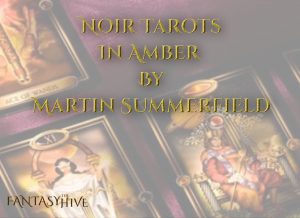 This is part of a series examining noir tropes and tarot archetypes in the first set of Chronicles of Amber Books. As a dabbling neophyte in tarot and a noir enthusiast, I’m fascinated by worlds peopled by people with ambiguous morals doing terrible things , but also by the Jungian archetypes in the tarot that are proliferate in the fantasy genre. Fair warning, there will be major spoilers as this is a deep dive of the books that will go into a great deal of plot detail.
This is part of a series examining noir tropes and tarot archetypes in the first set of Chronicles of Amber Books. As a dabbling neophyte in tarot and a noir enthusiast, I’m fascinated by worlds peopled by people with ambiguous morals doing terrible things , but also by the Jungian archetypes in the tarot that are proliferate in the fantasy genre. Fair warning, there will be major spoilers as this is a deep dive of the books that will go into a great deal of plot detail.
So the Hive has kindly given me free roam to post reviews of the Chronicles of Amber as well as my thoughts and impressions of the books through the lens of noir and tarot.
This week I’m going to be looking at Nine Princes in Amber by Roger Zelazny.
It all goes back to pulp. When Roger Zelazny and Michael Moorcock were at the forefront of fantasy’s new wave, fantasy books were a lot shorter and more concerned with telling a story economically and then moving on to the next book. And there is definitely something of the pulp in Zelazny’s Chronicles of Amber, being taut and spare books that had almost as much in common with the potboilers or noir genre than fantasy itself.
Noir is a tricky word to pin down with many definitions. The Cambridge Dictionary defines noir as “used for describing films or books that show the world as being unpleasant, strange or cruel.” Merriam Webster defines it as “crime fiction featuring hard-boiled cynical characters and bleak sleazy settings.” Probably the best definition I read was in an article by Nicholas Seeley who said that:
“Noir stories gave the stage to criminals and their motivations, which range from unspeakable passions to a firm conviction that their particular crime serves a greater good. A detective may pursue such a criminal, but noir reveals the line between them to be a product of chance and circumstance — if, indeed, such a line exists at all.”
The difference between hardboiled and noir was that hardboiled fiction was often about private detectives with alcohol problems and femme fatales and noir fiction was about the kind of people that do crimes and the fatalistic worlds that force them to do those crimes. Amber is both whilst occupying a series of dizzying fantasy/SF worlds that half of the time Corwin’s narration just mentions in passing; such as a world occupied by glass people whose organs were visible through their translucent bodies like anatomical dummies, a world with a Kentucky Fried Dinosaur fast food joint, and the actual Avalon from Arthurian fiction to name but a few.
Also of chief importance to the Chronicles of Amber is the tarot; or at least in Amber’s case, Zelazny’s own approximation of the tarot. Two main inspirations for the Amber books for Zelazny were his love of collecting tarot decks and also The Count of Monte Cristo, which we’ll come back to a bit later. For the purpose of this article, I’m using Biddy Tarot as the source for my interpretations of anything tarot related.
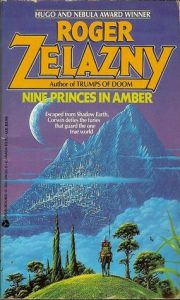 Our story begins with our hero, “Carl Corey” who he and we later discover is actually named Corwin, escaping from a mental hospital with no memory of who he is or how he got there. By dint of cunning, no small degree of canniness and bluffing, Corwin ends up outside of the residence of the person that put him there, his sister Flora. Flora is very much a femme fatale stereotype in her portrayal. While Corwin’s bluffing her, and she’s putting out feelers for his intentions on if he’s going to challenge for the crown, she says “you’re my favourite brother even though I know you’re crazy”, which has a very pulp feel to it, as does her appearance of a low cut dress. She also exhibits the moral flexibility of a femme fatale when Corwin tells her his intentions to challenge the crown, telling him that she thinks he can do it, promising she won’t tell Eric and kissing him. Royal families, eh? Flora is out for herself, but ultimately, so are all of the scions of Amber, she’s just not overly subtle about it. Flora could be best characterised in the tarot here as The High Priestess, dressed in colours of blue and green like the card representing fertility and the divine feminine. In the card the High Priestess is girded by two pillars, one black and one white, masculine and feminine and the duality of darkness and light. This can also be seen in her association with Eric, a feminine power in league with a masculine power, the very power that kept Corwin locked away in a mental hospital heavily sedated and monitored against his will.
Our story begins with our hero, “Carl Corey” who he and we later discover is actually named Corwin, escaping from a mental hospital with no memory of who he is or how he got there. By dint of cunning, no small degree of canniness and bluffing, Corwin ends up outside of the residence of the person that put him there, his sister Flora. Flora is very much a femme fatale stereotype in her portrayal. While Corwin’s bluffing her, and she’s putting out feelers for his intentions on if he’s going to challenge for the crown, she says “you’re my favourite brother even though I know you’re crazy”, which has a very pulp feel to it, as does her appearance of a low cut dress. She also exhibits the moral flexibility of a femme fatale when Corwin tells her his intentions to challenge the crown, telling him that she thinks he can do it, promising she won’t tell Eric and kissing him. Royal families, eh? Flora is out for herself, but ultimately, so are all of the scions of Amber, she’s just not overly subtle about it. Flora could be best characterised in the tarot here as The High Priestess, dressed in colours of blue and green like the card representing fertility and the divine feminine. In the card the High Priestess is girded by two pillars, one black and one white, masculine and feminine and the duality of darkness and light. This can also be seen in her association with Eric, a feminine power in league with a masculine power, the very power that kept Corwin locked away in a mental hospital heavily sedated and monitored against his will.
He has Flora’s hospitality, but not without warning that she has several trained German Shepherds who won’t hesitate to tear him to shreds if he steps out of line or goes snooping where he shouldn’t. Corwin uncovers a set of tarots that portrays both himself and his whole family, and he recalls a little of all of them, but especially a hatred of one of the cards, that of Eric.
Corwin could quite aptly be characterised here as The Fool from the tarot, stumbling and bluffing his way through a story he doesn’t understand, trying to outwit players he doesn’t know for a game whose stake he doesn’t understand. Also like the Fool, he starts from zero and his journey is cyclical because it also ends where it began. Corwin is narrating his story in first person to an unknown listener, the identity of which we only actually learn in the last book. But we’ll come back to that later.
Next enters Random, their mutual brother who is on the run from strange and shadowy beings. He asks for Corwin’s protection, and Corwin agrees to see how Flora will react. Corwin recalls that Random is nobody’s fool and that his presence may “serve as an ace, or at least a knave, in the hole.” If we accept Corwin’s impressions of Random, (and really, what choice to we have here, he’s the narrator) then Random could be viewed as the Jack of Coins – an opportunistic man trying to make more gold and good fortune manifest from the single gold coin he holds in his hand. He’s a gambler who’s always weighing the odds.
It’s worth mentioning here how Corwin is playing cards with people, manipulating their archetypes and playing with their lives for his own gain and survival. It’s also notable that in the opening chapters right up until Corwin arrives at Rebma with Random and his sister Deidre that Corwin is bluffing he has a Royal Flush or an Ace up his sleeve whereas really he is just playing for time “pretending knowledge [he] doesn’t possess,” all the while playing detective to a mosaic of broken memories and impressions he’s getting from the people that do have this information, his mutually murderous and in-fighting family. For a time he succeeds at this until he is backed into a corner and is actually forced to confide with his brother and sister that he’s just been winging it the entire time. Again, this plays quite well into the tropes of a hardboiled detective who lies, bluffs, deceives and wings it to get the information he needs before cracking the whole case wide open.
Our trio of dysfunctional siblings fight against Random’s shadowy pursuers, a bunch of monsters in trench coats and fedoras, and manage to dispatch them easily enough. Corwin at this point hasn’t confided in Random of his lack of memory, and Random takes him on a journey through shadow, essentially manipulating reality to travel through alternate worlds that the scions of Amber may be locating through their own preference or are actually creating through the magic of their bloodline. All roads lead to Amber, after all. During the journey Random is shocked when Corwin prevents him from murdering a fellow motorist that insulted him for them driving the wrong way on a road in an alternate world, showing us that the man that Corwin was held a lot less mercy than the man that Corwin currently is, sans memory.
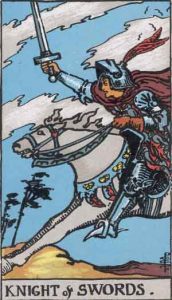 As they draw closer to Amber they reach the Forest of Arden and are hunted by the brother, Julian a ferocious knight in bone white armour riding a horse from nightmare. Julian could best be described in the Tarot as The Knight of Swords, a man of purpose and ambition, driven to succeed by any means necessary. Julian is as cold and ruthless as Christian Bale in American Psycho if he had a sword and a horse instead of a Genesis CD and a murder room. The pair eventually overcome him and escape for a time. The duo come across their sister Deidre captive as a damsel in distress and free her from her werewolf captors. There is a hint of incestuous romantic interest from Corwin to Deidre, as his narration says “God! She was lovely” and how he “took her into his arms because [he] wanted to, and squeezed her.” Deidre is harder to define than many of the rest of the scions of Amber as she doesn’t get as much page time, so she potentially fits into several archetypes of the Tarot such as Temperance, the Queen of Wands or Strength, but I think the closest comparison is the archetype Justice. Once driven to the underwater city of Rebma, a true reflection of Amber by necessity of dogged pursuit by their brother, Julian – Deidre advocates for Corwin, speaking for him to Queen Moire, explaining that he has no memory and seeks refuge in Rebma to walk the Pattern of Rebma to regain his memory; the Pattern itself being a labyrinth of leylines and magical energy that bestows the walker of the labyrinth with the power to walk through shadow worlds.
As they draw closer to Amber they reach the Forest of Arden and are hunted by the brother, Julian a ferocious knight in bone white armour riding a horse from nightmare. Julian could best be described in the Tarot as The Knight of Swords, a man of purpose and ambition, driven to succeed by any means necessary. Julian is as cold and ruthless as Christian Bale in American Psycho if he had a sword and a horse instead of a Genesis CD and a murder room. The pair eventually overcome him and escape for a time. The duo come across their sister Deidre captive as a damsel in distress and free her from her werewolf captors. There is a hint of incestuous romantic interest from Corwin to Deidre, as his narration says “God! She was lovely” and how he “took her into his arms because [he] wanted to, and squeezed her.” Deidre is harder to define than many of the rest of the scions of Amber as she doesn’t get as much page time, so she potentially fits into several archetypes of the Tarot such as Temperance, the Queen of Wands or Strength, but I think the closest comparison is the archetype Justice. Once driven to the underwater city of Rebma, a true reflection of Amber by necessity of dogged pursuit by their brother, Julian – Deidre advocates for Corwin, speaking for him to Queen Moire, explaining that he has no memory and seeks refuge in Rebma to walk the Pattern of Rebma to regain his memory; the Pattern itself being a labyrinth of leylines and magical energy that bestows the walker of the labyrinth with the power to walk through shadow worlds.
Moire herself could be best related to the archetype of The Star, a water bearer pouring water from one jug into another, seeking harmony and balance. Moire offers the trio asylum, but Random is kept captive in Rebma due to his past relationship with a princess of Rebma resulting in her suicide when he spurned her, after bearing his child, Martin. Random is forced to remarry a woman of Moire’s choice and remain a political prisoner in Rebma for a year which he has no choice but to accept. Moire reflects that Corwin has changed, as unlike many Lords and Ladies of Amber he has the capacity to love, again showing that Corwin has gained a little humanity along the way. The two make love and afterward Corwin takes his leave to walk the Pattern to regain his memories. Walking the Pattern is a trial of great effort both physically and mentally, but Corwin has to keep walking and not stray from the path or risk death. Through assaying the Pattern of Rebma, Corwin remembers his storied past, running the gamut from attending the Nuremberg trials, participating in the French revolution and surviving the Black Death, only to realise that it was the plague that had robbed him of his memory. During his walk through the Pattern he sees a fleeting shadow indicating that somebody else has also just completed the walk through the Pattern, a foreshadowing that will be important later when I cover The Guns of Avalon.
It’s worth discussing what archetype the Pattern itself would fit into. Much like Deidre earlier, there are several likely candidates such as the Wheel of Fortune and the Chariot, but perhaps the most apt archetype would be The World, as it is cyclical and represents a continuous cycle of acts completed and new beginnings. The card itself in the Rider Waite deck shows a woman stepping through a wreath completing one phase of her life only to begin another, and this seems like an apt representation of a maze or a labyrinth also being a journey to discovering one’s own power and also one’s true self. When Corwin discovers his true self in the centre of the labyrinth and comes into his own power, he teleports inside a hidden room in the Great Castle of Amber.
Within the castle Corwin actually reads the family cards like a tarot reading and sees bad things in store for the whole family. Unfortunately for this article there are no details on what spread Corwin uses, what question he asks the cards or how he reads them, but you could speculate by looking at the surviving Lords and Ladies of Amber, of which there is at least 10 that he could have possibly used the Celtic Cross spread. This focuses on 10 cards representing what is happening to the reader at the present, what challenges they are facing, the past, the future, above which represents their conscious goal, below which represents their subconscious drives and desires, advice which takes the prior cards into account and seeks to give the reader a recommendation on where to go from here, external influences, hopes and fears, and the outcome.
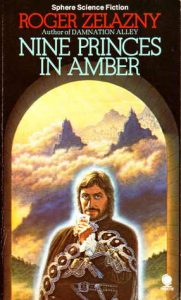 During his short visit in the castle, Corwin is attacked by his nemesis, Eric. Eric in many ways is The Tower card for Corwin. The two duel whilst also fighting a war of words and tossing insults. Eric represents The Tower, in the tarot and will be Corwin’s downfall later in the book. Corwin narrowly escapes with his life, using the stolen tarot to travel to his brother Bleys who is commanding an enemy fleet to invade Amber and overthrow Eric in his own personal effort to contest the crown.
During his short visit in the castle, Corwin is attacked by his nemesis, Eric. Eric in many ways is The Tower card for Corwin. The two duel whilst also fighting a war of words and tossing insults. Eric represents The Tower, in the tarot and will be Corwin’s downfall later in the book. Corwin narrowly escapes with his life, using the stolen tarot to travel to his brother Bleys who is commanding an enemy fleet to invade Amber and overthrow Eric in his own personal effort to contest the crown.
Bleys is portrayed, at least in appearance, as having similarities with The Devil card, holding a drink in one hand and a sword in another. Despite the fact it may be a deal with the devil, a deal is struck between them and an alliance is made as the two brothers join forces to press an attack against Eric. The two recruit a sizable army that view the brothers as gods, leading Corwin to question the morality of sending people to die for their claims to the crown. Perhaps due to this fit of conscience, he tries to contact his estranged and long thought dead father, Oberon who urges him to take the crown for himself. Oberon would at this stage best be portrayed as The Emperor, the ultimate patriarchal figure in all of the scions of Amber’s lives.
Corwin guides the fleet through shadow to attack Amber, but things quickly go from bad to worse, with both Bleys and Corwin’s fleets suffering from heavy losses. While Corwin negotiates with his brothers Caine and Gerard for clemency of his fleet, his second fleet is not so lucky as Eric strikes using the weather powers of the Jewel of Judgement wiping out a good deal of his crew and leaving Corwin himself shipwrecked for a time, clinging onto life. He rejoins Bleys and his forces and they mount an on foot attack, fighting up the Mountain of Kolvir to reach the summit in a last ditch desperate attempt to take the crown. It goes badly for them, and as Bleys falls from a cliff Corwin throws him his only means of escape in the form of the tarots and is captured and imprisoned in the dungeons by Eric’s forces. All is lost.
After a period of captivity, Corwin is brought up from the dungeons to witness Eric’s coronation and is handed the crown so he can suffer the humiliation of crowning Eric himself. This backfires as Corwin crowns himself first, proclaims himself to be the true King of Amber, only to be beaten up and taken to the dungeons to be blinded, making Eric’s crowning the last sight he will ever see. As the hot pokers burn out his eyes Corwin pronounces his death curse upon Eric and Amber. Blinded, he cannot escape as he can’t walk through shadow blind. Earlier I mentioned that Eric was The Tower – this is why. Eric has brought Corwin to his lowest possible point and taken from him the power and freedom he has newly gained. Years pass in captivity, and amazingly, Corwin’s eyes regenerate and his sight is restored, but he is still a captive with no means of escape. You can’t walk in shadow this close to Amber. He would have to somehow escape his cell, and either contact a family member by Tarot or walk far enough outside of Amber to be able to walk in shadow himself using his family’s powers of manipulating and creating an alternate reality of his desire. Thankfully, the means of his escape are at hand, as the family’s mad magician, Dworkin enters his cell via means unknown. Dworkin, as indicated, could be best described as The Magician archetype in the tarot as he is a conduit of energies between the spiritual and material world and uses these abilities to manifest his will in the material world. Dworkin tells Corwin that he has been imprisoned here by Oberon because he’s insane because he told Oberon he’d come up with a way to destroy Amber. Corwin asks him to draw the lighthouse of Cabra on his cell wall, and using the last of his matches manages to escape by walking through the newly made tarot. Corwin at this time, could be interpreted as The Hanged Man as he has been blinded, but gained knowledge during the process – he has learned the extent of his family’s regenerative powers, and his sacrifice for Bleys has also helped him learn important truths about Dworkin that will become more important later on in the books.
After a period of rest and recuperation thanks to the hospitality of Joplin the Lighthouse Keeper, a man best related to the archetype of The Hermit due to his life of solitude tending the lighthouse, Corwin is urged to look upon the Vale of Garnath via telescope, and he doesn’t like what he sees. Garnath is swathed in mist, the trees bent, gnarled and crooked and foul winged beasts emerge from it. Garnath is the result of Corwin’s death curse, the hate from his dark id made manifest. He has recognised his mistake, but not yet realised the full magnitude of it yet. He had opened a portal into Amber from an evil shadow. He sends a black messenger bird to Eric stating “I will return,” and a white messenger bird meant for Amber stating “I am coming.” The ending with black and white showing the duality of Corwin himself, of the righteous vengeance of his old life that he can’t seem to quite become untangled from and the optimism of him being able to return to his home in the way he truly wants to.
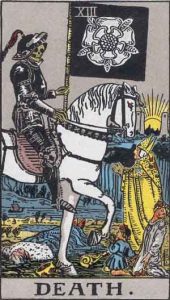 The ending also begs the question, who is Corwin when his memory has returned to him? Like the other characters, he doesn’t fit neatly into any one archetype but multiples. You could interpret him as the Jack of Coins for his ambition, as Random was earlier. Is he still the Fool even with his former knowledge, pursuing his ambition for the crown even when he knows it’s a doomed endeavour that will potentially cost him his life. Corwin knows that what he’s doing will perpetuate the cycle of family violence and vengeance, and like the wheel of fortune that he sees in a dream, just as you reach your highest point, just when you crest the mountain, is the point where things can only go downhill from there on. He is no longer the Hanged Man, as he has passed through his period of losing his sight and gaining knowledge from sacrifice, like an unwilling Odin. I’d say the closest archetype I can tie Corwin to is fittingly Death, the card being infamously misinterpreted as meaning only literal death when its primary interpretation is in fact change. It represents multiple changes within him that are still ongoing, although he still craves the crown he has grown a conscience and morality that has and still is making him a different person. He’s already been through the trauma of losing his memory in the Black Death, changing from Corwin to the amnesiac Carl Corey, and he has also undergone the years of being blind, imprisoned and at points losing his mind. Corwin has met Eric in the form of the Tower, and his life has been completely dismantled again for the first time since he lost his memory, and he has come through this traumatic event again a changed man. By the end of Nine Princes in Amber, he has also stated his intent that he will bring guns out of Avalon into Amber, so he will also literally become death like a minor Oppenheimer, by bringing death and destruction into Amber, staging an invasion with vastly superior weaponry. Metaphysical death has happened to both Carl Corey and Corwin of Amber, so who now is left? We shall see in Guns of Avalon.
The ending also begs the question, who is Corwin when his memory has returned to him? Like the other characters, he doesn’t fit neatly into any one archetype but multiples. You could interpret him as the Jack of Coins for his ambition, as Random was earlier. Is he still the Fool even with his former knowledge, pursuing his ambition for the crown even when he knows it’s a doomed endeavour that will potentially cost him his life. Corwin knows that what he’s doing will perpetuate the cycle of family violence and vengeance, and like the wheel of fortune that he sees in a dream, just as you reach your highest point, just when you crest the mountain, is the point where things can only go downhill from there on. He is no longer the Hanged Man, as he has passed through his period of losing his sight and gaining knowledge from sacrifice, like an unwilling Odin. I’d say the closest archetype I can tie Corwin to is fittingly Death, the card being infamously misinterpreted as meaning only literal death when its primary interpretation is in fact change. It represents multiple changes within him that are still ongoing, although he still craves the crown he has grown a conscience and morality that has and still is making him a different person. He’s already been through the trauma of losing his memory in the Black Death, changing from Corwin to the amnesiac Carl Corey, and he has also undergone the years of being blind, imprisoned and at points losing his mind. Corwin has met Eric in the form of the Tower, and his life has been completely dismantled again for the first time since he lost his memory, and he has come through this traumatic event again a changed man. By the end of Nine Princes in Amber, he has also stated his intent that he will bring guns out of Avalon into Amber, so he will also literally become death like a minor Oppenheimer, by bringing death and destruction into Amber, staging an invasion with vastly superior weaponry. Metaphysical death has happened to both Carl Corey and Corwin of Amber, so who now is left? We shall see in Guns of Avalon.
As we see from the best of noir, there are no simple answers or choices, and character motivations constantly shift as do the tarot archetypes. And like the best of noir, we are left with more questions than answers.

As I state on my own blog, no author or series that I discovered in my teens was more important in forming my love of reading and fantasy than Roger Zelazny’s Amber series. Not Tolkien, not Eddings, not Brooks, not even Moorcock (though he comes close). As a result I was drawn to your article like a moth to flame.
Yes Corwin’s imprisonment, escape, and quest for vengeance comes straight from The Count of Monte Cristo.
What a brilliant interpretation of characters in the book using aspects of the traditional Tarot! Well done, sir!
Thank you, that’s very kind.
[…] last but not least, almost pride of place in fact, goes to this very spoilery but excellent look by Martin at The Fantasy Hive at Nine Princes in Amber, looking spe… – take a […]